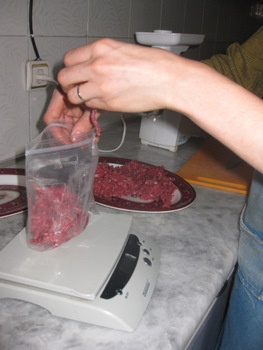Meat in Afghanistan...
How to Not Become a Vegetarian while Living in Afghanistan

Meat in Afghanistan is a cultural experience.
Everyone is different in their adaptability to different ways of doing things. Health wise, each body is different in its ability to cope with different germs and bacteria.
You may find you are able to cope just fine buying local fresh meat, the way Afghans do, pressure cooking it, and not getting sick. Others of us, however, need to take a little more time and money to avoid sickness while still enjoying meat.
Chicken Meat in Afghanistan
In many local bazaars in Kabul, frozen chicken breast is available and very good. This really does not need pressure cooking, and is great for making all types of chicken dishes.
We highly recommend all meat cooked in Afghanistan to the well done level.
Whole chickens are imported from Brazil, and these, while small, are tasty.
Beef Meat in Afghanistan
Beef, on the other hand, may take some getting used to. If you have a very knowledgeable guard, send him early in the morning to purchase the day's meat. This works for many people.
You can purchase "kofta" which is locally ground beef. It is common to get the occasional bone chip, however, and when the Afghan butcher puts the meat through the grinder, they value a lot of fat in the beef. They add fat, garlic, onions, sometimes carrots and potato to keep the grinder clean, and this will all get added to your kofta.
You can order "filet" or "pushtmagz", synonyms for the best cut of beef. This is usually the most tender part of the beef, but still usually needs a strong vinegar solution for a couple of hours to fully tenderize it. Pressure cooking always helps. We do cut it up for steaks, strips, kebabs, and cubes for stew.
We highly recommend all meat cooked in Afghanistan to the well done level.
Meat Day
Below, a highly competent colleague has described a thorough process of preparing your own beef. Once a month, she purchases a large quantity of beef, and prepares it for her family.
Meat Day: Cutting Your Own Meat in Afghanistan
About 2 days before I am ready to cut and grind some more beef, I send my guard to the local bazaar to speak with the butcher. My guard asks the butcher which day he will be butchering a cow, and then that is the day I send him to pick up the meat.
He goes very early in the morning, so that the meat will not have been sitting in the sun or have had flies on it all day. I ask him to bring back meat with no bones and no fat.
This usually means that I end up with a few good sized pieces of meat with only a minimal amount of fat on it and that I sometimes pay a slightly higher price per kilo. I find this cost increase to be worthwhile because then I don’t have to throw away a kilo of fat that I have already paid for.
Once I have the meat, I let it sit in my fridge for a couple of hours until my baby is ready for nap time. It is more convenient and I find it makes it a little easier to trim.

The first step is to trim each of the pieces of as much fat as possible. Fat tends to contain the most toxins, and since we have enough environmental toxins to deal with here, I try to minimize the amount we ingest.
As I trim, I also separate the meat into 2 piles: one to grind and the other to cut. The "grind" pile is usually composed of the pieces that are tougher, smaller or have more fat mixed in with the meat.

I put any softer, larger pieces of meat into the "cut" pile. Once it has all been trimmed I decide what to do with each piece. This varies greatly depending on what kind of meat I’ve been able to get.
If the meat is evidently from a younger animal and of better quality, I try to cut at least 1 or 2 roasts out of the best cuts of meat. The meat here, given the halal requirements, is not aged at all, so it tends to be tougher than you would expect in other places.
Therefore, I usually pressure cook the roasts to make them more tender. I often take some of this softer meat and cut beef strips out it. From the meat that is a little tougher, but not so tough that it is only fit to grind, I also try to cut a few packages of stew meat.

The rest or any small pieces left after I am finished cutting, I put in the grinding pile.
When the trimming, cutting and grinding are complete, I usually have about 8 ½ to 9 pounds of usable meat. I never use the meat fresh, always allowing it to be solidly frozen first to hopefully make it a little safer to eat.
The advantages for my family over what I can buy locally are that the meat is much leaner and lacking bone chips. As a friend can attest, the extra work is worth not having to visit your dentist after dinner!
Enjoy your meat in Afghanistan, but cook it well. Just some motherly advice...

Food Shopping in Afghanistan
Read an itemized list of what is available in Afghanistan
Return from Meat in Afghanistan to Living in Afghanistan
From Meat in Afghanistan go Home
